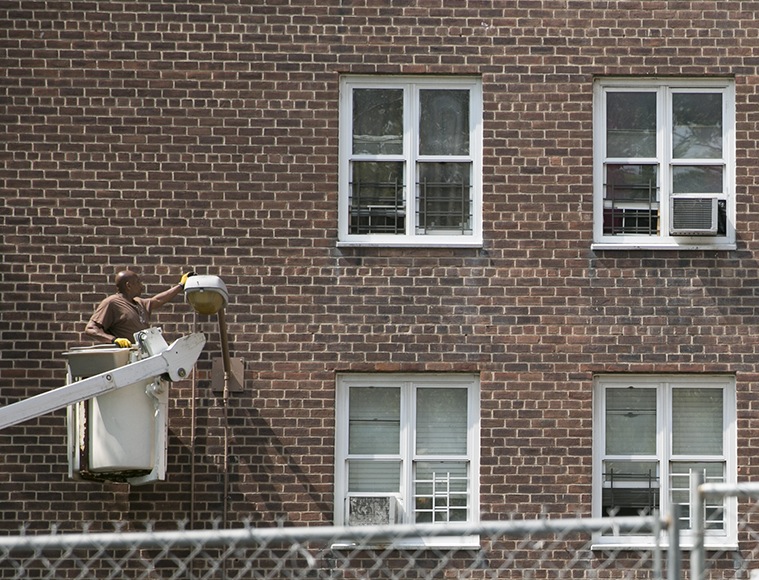
William Alatriste for the New York City Council
Work underway at NYCHA's Red Hook Houses in 2014.
Last week New York learned the scale of the budget blow that the Trump administration is gearing up to deliver to the New York City Housing Authority. On Monday, members of the City Council will start to learn how to deal with it.
The preliminary budget hearing by the Council Committee on Public Housing is at 1 p.m. in the main Council Chambers and can be watched here. Committee Chairman Ritchie Torres, a Bronx Democrat, has supported the innovative and sometimes controversial development strategies that NYCHA has undertaken under Mayor de Blasio and NYCHA Chairwoman Shola Olatoye, though Torres has often been critical of the authority’s process and transparency. It will be interesting to watch how the relationship between Council progressive and the administration responds to the heightened external threat to public housing in New York City.
Also last week, the Community Service Society of New York (the former parent organization of City Limits and still a funder) published a detailed assessment of NYCHA’s progress and challenges. The comprehensive report by veteran NYCHA expert Vic Bach finds that despite recent efforts by de Blasio to address some of NYCHA’s needs, “after decades of government disinvestment, resident living conditions continue to be deplorable, far worse than those facing low-income tenants in the private rental market.”
“Public housing residents, unlike their low-income counterparts in the private rental market, are shielded from the affordability crisis–federal law requires their rents be capped at 30 percent of household income, the prevailing affordability standard,” Bach continues. “Instead, they face an infrastructural crisis, marked by a steady decline in living conditions that has accelerated in the last decade.” The research shows that while tenant complaints about conditions in NYCHA were on par with those by private-market tenants in 2002, conditions in NYCHA worsened significantly over the next decade before leveling off (at a high level) in the past couple years.
And the population affected is more economically diverse than commonly thought, with 5 percent of households reporting incomes about $74,000, 60 percent of households reporting some employment income (with 39 percent only getting money from work) and only 9 percent receiving revenue from traditional welfare; though a quarter of NYCHA households receive Supplemental Security Income, only 7 percent have SSI as their exclusive source of money.
A key conclusion of the report is that NYCHA’s tenants represent a “sleeping giant”: a “third city” larger than Atlanta or Minneapolis which, if NYCHA resident associations took advantage of their powers and the outside organizations poised to pitch in, could force an end to the dangerous bifurcation of housing policy and advocacy in New York, which puts “affordable housing” in one bucket and all things NYCHA in a separate one.
The way to save NYCHA, Bach writes, “is to stir the ‘sleeping giant’ to act and exert the grass-roots political pressure that will impel government leaders to respond, particularly with local and state elections coming up in the next two years.”
Read the CSS report here.









One thought on “NYCHA’s Budget Crisis: A ‘Must Watch’ and a ‘Must Read’”
This is spot on. It is absurd the way this city is a tale of 3 cities. Wake up NYCHA Residents!